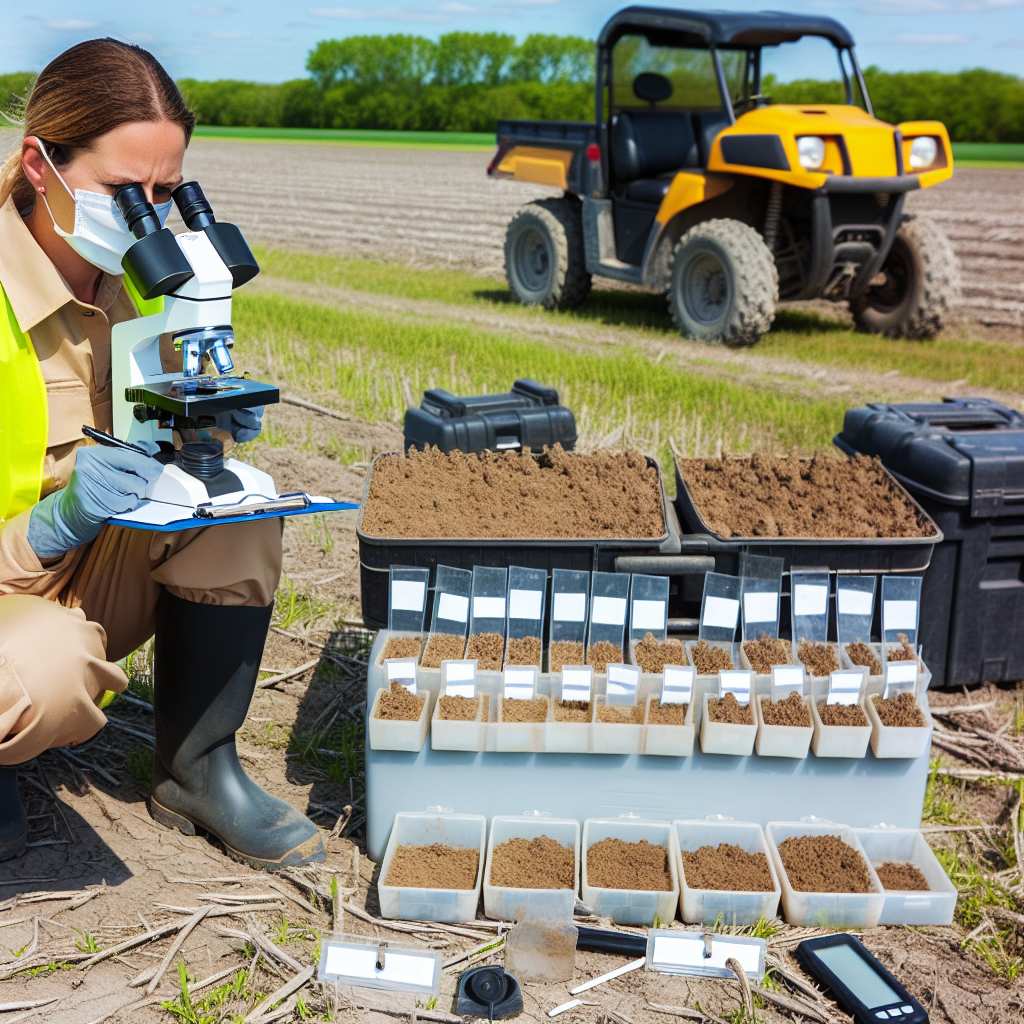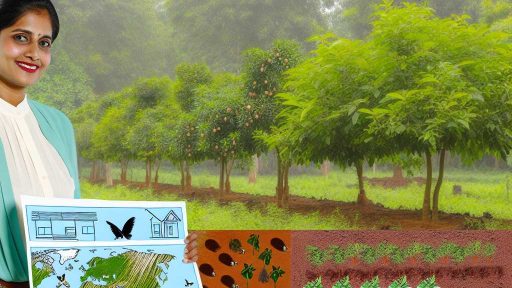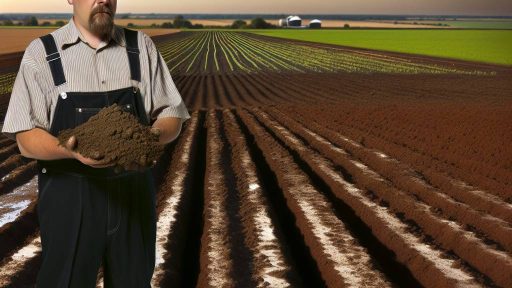Introduction to Soil-Borne Diseases
Soil-borne diseases significantly affect agricultural productivity worldwide.
These diseases originate from pathogens residing in the soil.
Consequently, they can devastate crops and impact food security.
Understanding these diseases is crucial for effective management.
Importance of Soil-Borne Diseases
Soil-borne diseases pose a threat to yield and quality of crops.
They can lead to the rapid decline of plant health.
Additionally, infected plants may produce lower yields.
This decrease can affect both farmers and consumers.
Moreover, the economic implications of such losses are significant.
Common Soil-Borne Pathogens
Numerous pathogens contribute to soil-borne diseases.
Fungi, bacteria, and nematodes are among the most damaging.
Fusarium wilt and root rot are notable fungal diseases.
Some bacteria, such as Ralstonia solanacearum, are also harmful.
In addition, nematodes can cause severe root damage.
Impact on Agricultural Practices
The presence of soil-borne diseases alters farming practices.
Transform Your Agribusiness
Unlock your farm's potential with expert advice tailored to your needs. Get actionable steps that drive real results.
Get StartedFarmers may need to change crop rotations and planting strategies.
Moreover, these diseases can increase the use of chemical controls.
This can lead to higher production costs and environmental concerns.
Moreover, the persistence of pathogens in the soil complicates management.
Potential Long-Term Effects
Soil-borne diseases can have lasting consequences on soil health.
Repeating cycles of disease can lead to soil degradation.
This impacts future crop production and ecosystem balance.
Additionally, continuous cropping can exacerbate pathogen resilience.
Ultimately, these effects threaten sustainable agricultural practices.
Common Types of Soil-Borne Diseases Affecting Crops
Overview of Soil-Borne Diseases
Ssoil-borne diseases pose significant challenges for agriculture.
These diseases impact crop health and yield directly.
Identifying these diseases early can help mitigate losses.
Fungal Diseases
Fungal pathogens are among the most common soil-borne threats.
They thrive in warm, moist soil conditions.
Common fungal diseases include root rot and wilt.
For instance, Fusarium wilt can devastate entire fields.
Additionally, Phytophthora infestans causes late blight in potatoes.
Bacterial Diseases
Bacterial diseases also significantly affect crops.
They can spread rapidly through soil and water.
Common bacterial diseases include bacterial wilt and canker.
For example, Ralstonia solanacearum causes bacterial wilt in tomatoes.
These infections can lead to severe yield losses if untreated.
Nematode Infestations
Nematodes are microscopic worms that can harm plant roots.
They feed on roots and can stunt plant growth.
Showcase Your Farming Business
Publish your professional farming services profile on our blog for a one-time fee of $200 and reach a dedicated audience of farmers and agribusiness owners.
Publish Your ProfileRoot-knot nematodes are particularly damaging in many crops.
These pests often require integrated pest management strategies.
Managing Soil-Borne Diseases
Effective management is crucial for protecting crops.
Crop rotation can help disrupt disease cycles.
Planting resistant varieties also proves beneficial.
Furthermore, proper soil health management promotes resilience.
Regular soil testing aids in early detection of pathogens.
The Role of Soil Health in Prevention
Maintaining healthy soil is vital in disease prevention.
Healthy soil supports beneficial microorganisms that combat pathogens.
Practices like cover cropping enhance soil structure and health.
Additionally, sustainable fertilization can improve soil vitality.
Ultimately, promoting biodiversity in the soil supports crop health.
Identifying Symptoms of Soil-Borne Diseases in Plants
Overview of Soil-Borne Diseases
Soi-borne diseases are a significant threat to agriculture.
They affect various crops and can lead to severe financial losses.
Identifying their symptoms early is crucial for effective management.
Common Symptoms
Plants affected by soil-borne diseases often show various symptoms.
Wilting is a frequent indication, even in well-watered plants.
Furthermore, stunted growth may occur, impacting overall yield.
Yellowing of leaves is another common symptom.
Additionally, plants may exhibit root decay or rot.
This damage leads to reduced nutrient uptake and weakened plants.
Specific Disease Indicators
Different diseases may present unique symptoms to observe.
Fusarium Wilt
Fusarium wilt manifests through yellowing leaves and wilting.
Inspecting the vascular tissue may reveal darkened areas.
Root Knot Nematodes
These pests cause distinct galls on root systems.
As a result, plants may demonstrate overall poor health.
Phytophthora Root Rot
Phytophthora root rot often leads to blackened roots.
Additionally, affected plants may wilt and die unexpectedly.
Diagnosis Techniques
Accurate diagnosis is essential for effective treatment.
Visual inspection is the first step in identifying symptoms.
Soil tests can provide valuable information on disease presence.
Laboratory analysis may be necessary for definitive diagnosis.
Preventive Measures
Taking proactive measures can prevent soil-borne diseases.
Rotating crops helps disrupt disease life cycles.
Additionally, proper sanitation practices reduce pathogen spread.
Using disease-resistant plant varieties provides another layer of protection.
Gain More Insights: Agroforestry Strategies for Climate-Resilient Land Development
Preventative Measures: Best Practices for Soil Health Management
Understanding Soil Health
Soil health is critical for successful agriculture.
Healthy soil supports robust plant growth.
Moreover, it enhances soil structure and fertility.
Showcase Your Farming Business
Publish your professional farming services profile on our blog for a one-time fee of $200 and reach a dedicated audience of farmers and agribusiness owners.
Publish Your ProfileThus, managing soil health is key to preventing diseases.
Crop Rotation
Crop rotation is a proven method for enhancing soil health.
This practice involves alternating different crops in the same field.
It disrupts the lifecycle of soil-borne pathogens.
Additionally, it improves nutrient balance in the soil.
Farmers should consider rotating with legumes and cover crops.
Cover Crops
Using cover crops strengthens soil health.
These plants prevent erosion and improve soil structure.
They also enhance biodiversity within the soil ecosystem.
Furthermore, cover crops can suppress weeds effectively.
Farmers should choose species that align with their main crops.
Soil Testing
Regular soil testing is essential for effective management.
This practice reveals nutrient deficiencies and pH levels.
Based on results, customized fertilizer applications can be planned.
Understanding soil composition helps in making informed decisions.
Organic Amendments
Adding organic amendments boosts soil fertility.
These include compost, manure, and green manures.
Such materials enhance microbial activity in the soil.
In turn, they increase nutrient availability for plants.
Water Management
Proper water management prevents soil-borne diseases.
Overwatering can lead to root rot and fungal infections.
Implementing drip irrigation reduces excess moisture.
Additionally, maintaining optimal drainage is crucial for healthy crops.
Pest and Disease Monitoring
Regular monitoring plays a vital role in disease prevention.
Farmers should look for early signs of pests and diseases.
Implementing an Integrated Pest Management (IPM) plan can help.
This combines various biological and chemical control methods.
Staying vigilant ensures timely interventions.
Discover More: Drought Management Strategies for Sustainable Agricultural Land Investments
Crop Rotation: A Sustainable Strategy to Manage Soil-Borne Diseases
Understanding Crop Rotation
Crop rotation involves alternating the species of crops grown on a particular area over time.
This technique disrupts the life cycles of soil-borne pathogens.
By rotating crops, farmers can minimize disease incidence in their fields.
Additionally, this practice enhances soil fertility and health.
Benefits of Crop Rotation
Crop rotation offers numerous benefits for agricultural land investments.
First and foremost, it reduces the buildup of diseases and pests.
Moreover, different crops utilize various nutrients from the soil.
This leads to improved soil nutrient content over time.
Additionally, crop rotation promotes biodiversity in farming systems.
Implementing a Crop Rotation Plan
A successful crop rotation plan requires careful consideration of various factors.
Farmers should first assess the specific diseases present in their fields.
Showcase Your Farming Business
Publish your professional farming services profile on our blog for a one-time fee of $200 and reach a dedicated audience of farmers and agribusiness owners.
Publish Your ProfileNext, they should select crops that are less susceptible to these diseases.
For instance, integrating legumes into the rotation can enhance soil nitrogen levels.
Furthermore, planning the timing and sequence of crops is essential.
Common Crop Rotation Strategies
There are several effective strategies for crop rotation.
One popular method is the three-year rotation cycle.
- Year one: Plant a cereal crop.
- Year two: Follow with a legume.
- Year three: Conclude with a root or brassica crop.
Another approach involves alternating deep and shallow rooting crops.
This can enhance nutrient absorption and soil structure.
Challenges in Crop Rotation
While beneficial, crop rotation does come with challenges.
One common issue is the need for expanded land or longer time commitments.
Additionally, farmers must stay informed about best practices and crop choices.
Maintaining market demand for rotated crops can also pose a challenge.
Benefits of Sustainable Crop Management Strategies
Crop rotation is a vital practice for managing soil-borne diseases.
This sustainable strategy not only protects crops but also supports long-term agricultural health.
By implementing effective crop rotation plans, farmers can safeguard their land investments.
Gain More Insights: How Sustainable Irrigation Improves Soil Health and Crop Yields
Biological Control: Utilizing Natural Predators and Beneficial Microorganisms
Introduction to Biological Control
Biological control leverages natural mechanisms to combat soil-borne diseases.
This method focuses on using organisms that naturally suppress pathogens.
Both predators and beneficial microorganisms play crucial roles in this process.
Natural Predators
Natural predators include insects and other animals that feed on harmful pests.
For example, ladybugs reduce aphid populations effectively.
Introducing such predators can prevent disease spread in crops.
Additionally, these predators help maintain ecological balance in farming systems.
Benefits of Natural Predators
Utilizing natural predators reduces the need for chemical pesticides.
This practice promotes a healthier farming environment.
Moreover, it enhances biodiversity, which is essential for resilient ecosystems.
Beneficial Microorganisms
Beneficial microorganisms, including bacteria and fungi, improve soil health.
They compete with pathogens for nutrients and space in the soil.
Soybean nematodes can be controlled by specific nematophagous fungi.
This interaction significantly lowers disease incidence.
Types of Beneficial Microorganisms
- Mycorrhizal fungi enhance nutrient uptake in plants.
- Rhizobacteria can promote plant growth and reduce disease symptoms.
- Actinomycetes produce antibiotics that suppress fungal pathogens.
Application of Beneficial Microorganisms
Farmers can apply them through soil amendments or foliar sprays.
Regular use of these microorganisms encourages sustainable soil management practices.
Furthermore, they contribute to improved crop yields over time.
Integrating Biological Control into Farming Practices
Farmers need to consider their specific agricultural context.
Applying biological control strategies requires understanding ecosystem dynamics.
Moreover, integrating these strategies with traditional methods can yield better results.
Education and training in biological control are necessary for effective implementation.
Challenges and Considerations
Some challenges may arise when introducing biological control methods.
For instance, achieving the right balance of predators and pathogens is crucial.
Additionally, monitoring pest levels and effectiveness is essential.
Farmers should also be aware of local regulatory guidelines related to biological control.
Showcase Your Farming Business
Publish your professional farming services profile on our blog for a one-time fee of $200 and reach a dedicated audience of farmers and agribusiness owners.
Publish Your ProfileExplore Further: Best Soil Conservation Practices for Residential and Commercial Landowners

Chemical Management: When and How to Use Fungicides and Chemicals Safely
Understanding Chemical Management
Chemical management is essential in protecting crops from soil-borne diseases.
Farmers need to understand the role of fungicides in disease control.
Proper use minimizes risks to both crops and the environment.
Choosing the Right Fungicides
Selecting the appropriate fungicide is crucial for effective management.
Consider the specific diseases affecting your crops.
Also, evaluate the effectiveness and safety of the product.
Consult agricultural specialists for recommendations.
When to Apply Fungicides
Timing plays a significant role in the success of fungicide application.
Apply fungicides before visible symptoms appear for maximum effectiveness.
Monitor weather conditions, as rain can wash chemicals away.
After heavy rainfall, reapplication may be necessary.
How to Apply Fungicides Safely
Safety is paramount when using fungicides.
Always wear appropriate protective gear during application.
Follow the manufacturer’s instructions on dosage and method.
Use application equipment that provides accurate distribution.
Environmental Considerations
Consider the environmental impact of chemical use.
Avoid applications near water bodies to prevent contamination.
Use integrated pest management strategies to reduce reliance on chemicals.
Regularly assess the effectiveness and adjust practices accordingly.
Alternatives to Chemical Management
Explore alternative methods to reduce chemical dependency.
Use crop rotation to disrupt disease cycles.
Introduce resistant crop varieties as a preventive measure.
Enhance soil health through organic amendments and cover crops.
Integrated Pest Management Approaches for Soil-Borne Disease Control
Understanding Soil-Borne Diseases
Soyl-borne diseases pose significant threats to agriculture.
These diseases can severely affect crop yield and quality.
Identifying these diseases early is crucial for effective management.
Common soil-borne pathogens include fungi, bacteria, and nematodes.
Farmers must recognize the symptoms that indicate soil-borne issues.
Key Integrated Pest Management Strategies
Integrated Pest Management (IPM) combines various strategies.
This approach focuses on sustainable and effective solutions.
Implementing cultural practices is vital in managing soil-borne diseases.
Crop rotation disrupts the life cycle of pathogens.
Choosing resistant crop varieties enhances disease resistance.
Proper irrigation techniques can minimize disease spread.
Soil Health Management
Maintaining soil health plays a crucial role in disease prevention.
Healthy soils support beneficial microorganisms that compete with pathogens.
Regular soil testing helps identify nutrient deficiencies.
Adding organic matter improves soil structure and can suppress diseases.
Practicing cover cropping can enhance soil fertility and reduce erosion.
Showcase Your Farming Business
Publish your professional farming services profile on our blog for a one-time fee of $200 and reach a dedicated audience of farmers and agribusiness owners.
Publish Your ProfileBiological Control Methods
Biological control offers sustainable disease management options.
Beneficial microorganisms can outcompete or inhibit pathogens.
Utilizing mycorrhizal fungi enhances plant resilience to disease.
Applying biofungicides can provide an alternative to chemical treatments.
Farmers should explore these options as part of their IPM plans.
Chemical Control Options
When necessary, chemical control can be part of an IPM strategy.
Fungicides can provide effective management of soil-borne pathogens.
However, over-reliance on chemicals can lead to resistance.
Careful application timing enhances efficacy while limiting risks.
Farmers must follow guidelines to minimize environmental impact.
Education and Training
Ongoing education is essential for effective disease management.
Farmers should participate in workshops and training programs.
Collaboration with local agricultural extensions can provide valuable insights.
Staying informed on the latest research can improve management practices.
Networking with fellow farmers promotes shared learning and best practices.
Continuous Monitoring and Assessment of Soil Health for Early Detection
The Importance of Soil Health Monitoring
Soil health monitoring is essential for sustainable agriculture.
Regular assessments help identify soil-borne diseases early.
Early detection leads to better management strategies.
Farmers can enhance crop yield and protect investments.
Thus, proactive monitoring is a meaningful component of farm management.
Key Indicators of Soil Health
Several indicators reflect soil health status.
- Soil pH significantly influences nutrient availability.
- Organic matter content improves soil structure.
- Microbial activity helps in nutrient cycling.
- Soil moisture levels are critical for crop growth.
Understanding these indicators guides farmers in their management practices.
Implementing Regular Soil Testing
Soil testing provides valuable information about nutrient levels.
Farmers should conduct tests at least once a year.
Testing reveals the presence of harmful pathogens.
Results guide appropriate fertilizer and amendment applications.
Utilizing Technology for Soil Health Assessment
Modern technology enhances soil health monitoring.
Soil sensors provide real-time data on moisture and nutrients.
Drones can survey large fields efficiently.
Data analytics helps in making informed decisions quickly.
Integrating technology leads to better resource management.
Establishing a Monitoring Schedule
A systematic monitoring schedule is vital for success.
Farmers should decide on sampling frequency based on crop cycles.
Seasonal variations may require specific testing approaches.
Staying consistent can offer long-term insights into soil health.
Response Strategies to Soil Health Issues
Identifying soil health issues requires timely intervention.
Crop rotation can disrupt disease cycles effectively.
Incorporating cover crops improves soil structure and fertility.
Additionally, organic amendments can restore microbial balance.
These strategies together enhance soil resilience against diseases.
Showcase Your Farming Business
Publish your professional farming services profile on our blog for a one-time fee of $200 and reach a dedicated audience of farmers and agribusiness owners.
Publish Your ProfileAdditional Resources
Partnerships for Climate-Smart Commodities Project Summaries …
Chapter 5 : Food Security — Special Report on Climate Change and …




